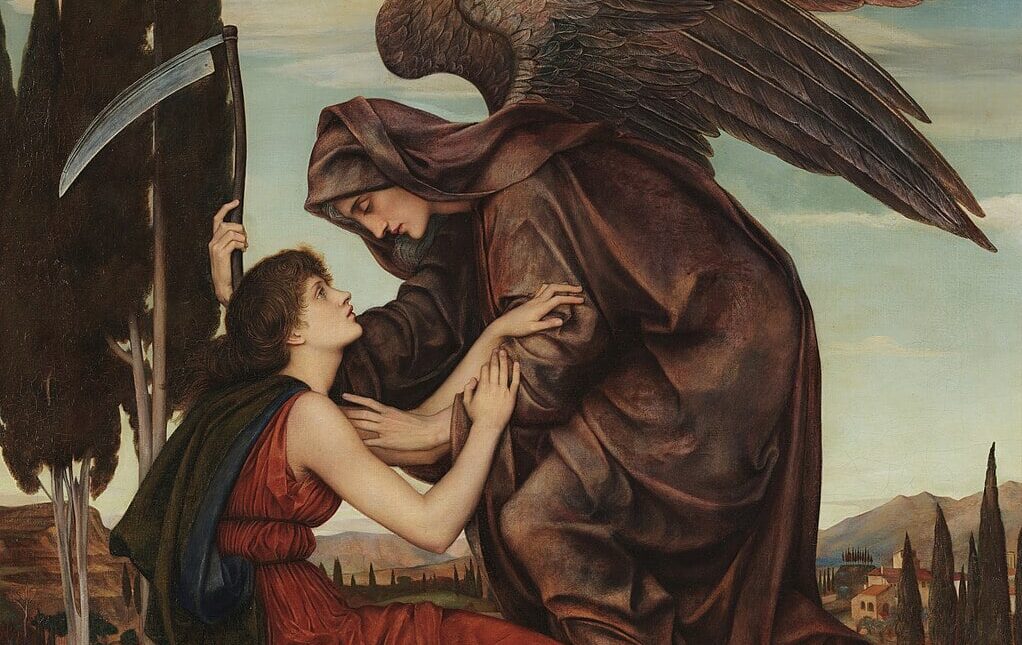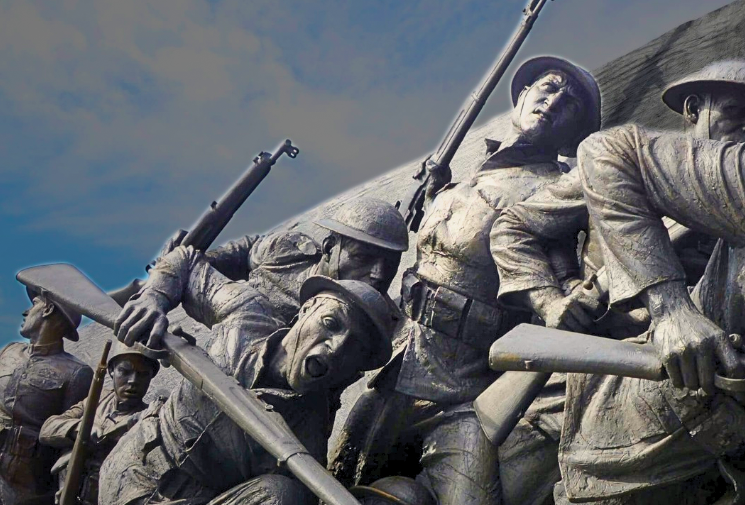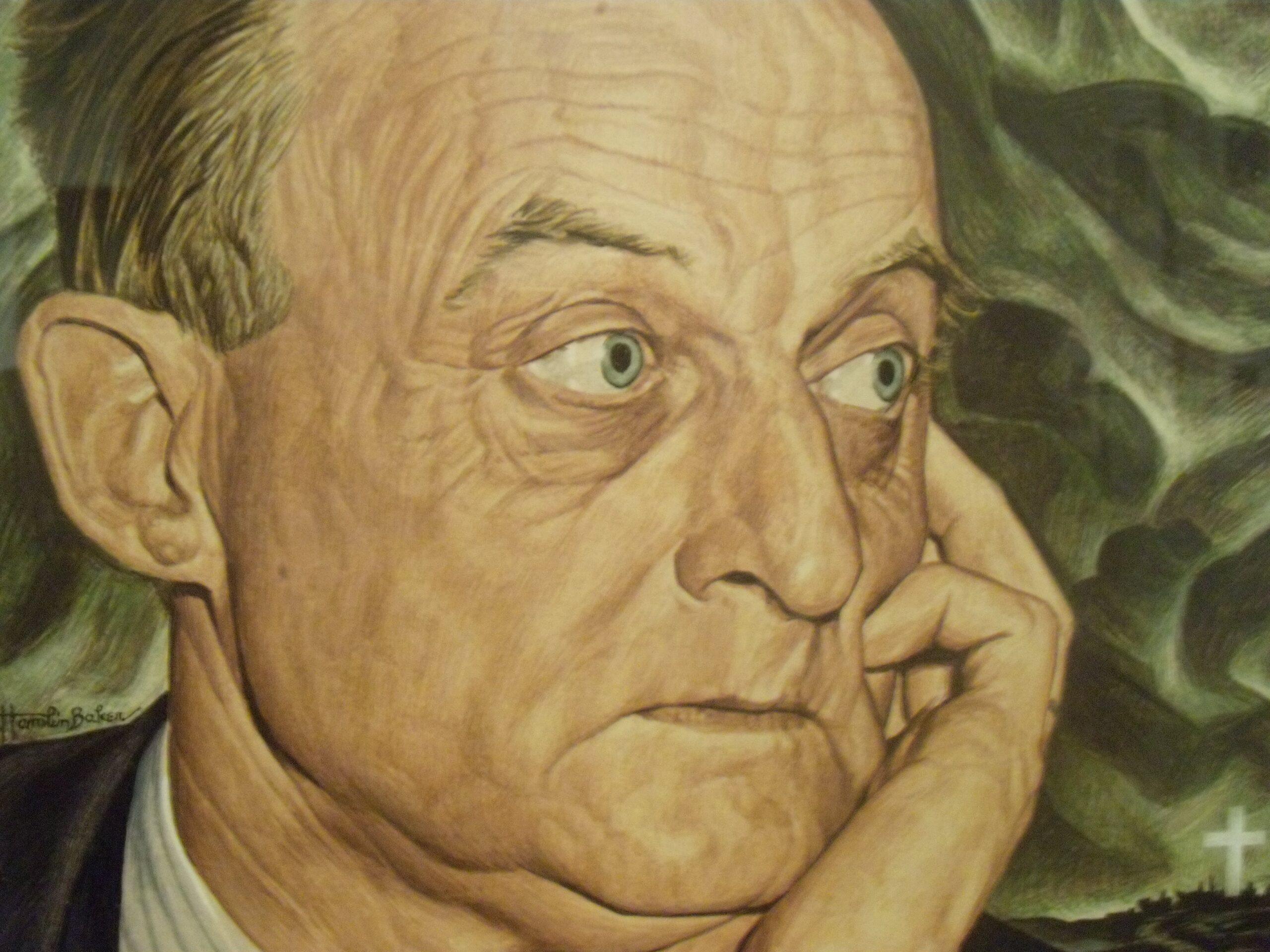I. Trompe l’oeil
From the time she wrapped her head in scarves,
The time I best recall she wore as well a cap
And gown of purest bridal white. A ceremony of
Beginning, by tradition held in daylight
On the expanse of lawn beside the school,
That day took place inside instead.
The forecast called for an evening thunderhead,
So “out of abundance of caution,”
Declared the school Head, the pageantry
Would move indoors. But I knew their true concern
Was before the storm: the heat and sun—
Likely too much for the one in the scarf.
Over her shoulder from under her cap it flowed
To her waist, a shimmer of golden mane—locks real
As those of Venus or Soredamor, or Tristan’s lover
Or Thor’s: were her mother and I Ethiopian royals
Entwined under Andromeda’s gaze,
Still we could not have begot such displays.
What we couldn’t do, the silkworms could.
Thousands of them in their final task,
They’d spun the base for a stunning illusion.
Her eyebrows she drew on hairless pale skin.
Completing the look, she was slightly too thin
From the raging poisons working within.
“Please hold your applause,” the emcee said.
As the roll progressed, the assembly mostly did.
But then came her turn. She crossed the stage.
He read her name. She turned to us.
The clapping began and became an ovation,
A wave she absorbed with radiant poise.
The parents of classmates mostly knew
In general terms what she’d been through.
Their applause was heartfelt, but also ran scared—
Unspoken thanks their daughter was spared.
Far-flung uncles and aunts, grandparents as well?
Once “hair” clicked as “scarf,” it spoke for itself.
II. Dr. Miller’s Distant Youth
Miller, then just out of medical school,
And rutting his way through the nursing pool,
Indulged morbid humor with a corny tendency
To give sudden deaths’ cause as “acute numerical ascendancy”:
Yup—
Their numbers came up.
III. Warp and Woof
Gold for faux locks was never in doubt:
She and her cousin were Captains of Gold,
Led the Gold team to glory over hapless Purple.
But not for want of choices available—
A box of scarves she had available,
Myriad silks for every occasion.
Solids and stippleds, paisleys, patterns,
A scrambled Pantone wheel in a box.
A box fully a cubic foot, filled to the top,
Four dozen? Five? Neatly folded
(At least at first), boxed carefully away—
Awaiting unpacking some needful day.
Where does one get such a fine box of scarves?
From a curator faced with like circumstance:
The need for a headdress in place of dead hair.
A response to a need now thankfully passed,
The box here attests to the poison’s success:
Reborn roots sending silks through the scalp to the air.
This is where I come in again.
Over here, my daughter; over there, a friend,
A woman of substance nine years my senior,
Known to me since my college days
(I met her a year past my daughter’s age),
The eldest sister to my best classmate-pal.
Then, I was a manchild gingerly approaching
The Crossroads where she’d lived all her life—
A dark and bloody place, so some would say.
But to me it was the promised land, where
The liveliest minds went to work and play.
Her radiant presence bid welcome my way.
She could have written madcap novels,
Could have created famous art.
With the prick of her wit she could deftly deflate
The bloated pretense of the famous and great.
But she spurned all striving in pursuit of fame.
Her ambition instead was for life.
All of hers entailed perfect passion.
Her love, with her husband’s, she wove like maille;
With her children and family, the same.
Yet I too knit in, and others as well,
In a fashion that made each one understand
How familial each was, in all but name.
She loosed herself on the world before her,
Selecting the beautiful and lovely to love,
Marking the cowardly and base to hate,
And above all, I think, loving to discriminate—
The act of picking apart good motive from bad,
The psychologist’s art she preeminently had.
This bothered me a little, I confess.
I cultivate repute the same as the rest.
It entails the artful concealment of flaws.
At the Crossroads, not unbloodied, I’ve known success—
But then my mind wanders to her powers of discernment.
She x-rayed everyone; me too, I’d guess.
She would have shared the results with her husband,
Perhaps others among the familial as well,
She would have been funny, incisively cutting.
Had I heard what she said, my cheeks would be red,
As if singed by a spark of shame from hell.
The thought alone makes them hot for a spell.
Thirty years’ wear must test all connections, and
Most fall apart, the warp insufficient to bind
The youthful dreams with which we’re woofed.
“It’s been too long!”—the words of survival
Of auld lang syne, pleasantly recalled,
Yet without much chance of current revival.
Sometimes, though, the weaver’s art holds,
And we find ourselves in a bond
Of that familial kind. The test
Is clear: on meeting again, after weeks
Or a year, must we catch up?
Or is being together by itself enough?
To start a conversation as if years
Were a day: no—not to start, but to resume.
This is a trick of travel through time.
Two people woven in a permanent present,
Each the warp to the other’s woof—
The weaver’s art a joint possession.
The scarves, she made clear, were only on loan.
A permanent loan, one could hopefully say.
When my daughter’s need had passed (for the better!),
We should box them back up and put them away—
And fear not a day when again they must attend
To the needs of someone familial, or a friend.
IV. R.I.P.
From twenty-five hundred miles distant,
My wife was calling: come home now.
There’s been an infection, a wildfire fever,
She’s in the hospital. You need to be here.
I booked the next flight,
Wrote colleagues to say I was leaving that night.
On the plane at last,
I considered the worst—
This occasion was the first:
The message I’d write to family and friends,
Its subject-line her name, plus “R.I.P.”
It overcame me.
V. The Soldier
Luckily Miller turned up at muster
With medical counsel for overcome me.
“Her immune system is shot from chemo;
Infections like this are fairly routine.
Positive pressure in the hospital room
Keeps it microbially very clean.
“When the antibiotics have dripped their course,
She’ll be okay. You shouldn’t worry.”
This was meant to reassure me, and
At first, it did. But recall, these words
Came straight from the champ of the aleatory,
As if chance played no role in this or any story.
VI. Reunions
The poisons on the good side won.
We watched her hair redone—in ginger curls.
By now, it’s auburn and straight once more,
The roots resilient; no occasion for scarves.
Five years later, the statistics assure,
It’s as if nothing ever happened to her.
Her mother packed up the box of silks,
The solids, paisleys, patterns, and stippleds—
All neatly folded, the gold scarf on top,
Some fifty scarves boxed neatly away,
A suitable scarf for any occasion,
Awaiting unpacking another day.
For several years, I’d been with my friend
On nearly every weekday—she worked for me
At the Crossroads then, a currency trader
In words and wordplay.
We had our serious business to do,
But rarely let it get in the way.
I recall the particulars of very few
Of a thousand crackling conversations. To summarize
Their flavor, from a ribald poem she wrote, I quote three lines:
O, schadenfreude, your name, your lovely name, is “Client 9”!
“I disappoint my Spitzy self and wife,” he testifies.
“But how I love the spanky-spanky valentine!”
Then she left me—as I’d say—for another man.
Her husband returned from a consuming task
That had kept them mostly apart for years.
All she’d ask now was time for resuming
Where they’d left off, their intimate present:
Warp and woof, under the same roof.
I stayed mostly away from the two,
Untroubled by my conclusion
That too much of me would be an intrusion—
Plus the burn from a possible X-ray review.
I had the sense, too, that we (she and I)
Would pick up again, even years gone by.
And this is the problem with permanent present,
With knowing the trick of travel through time,
With the weaver’s art as a joint possession:
It assumes the permanence of warp and woof—
That a time for resumption will certainly arrive
While both entwined parties are still alive.
The box of scarves didn’t stay packed for long—
She needed them back in less than a year.
Something went wrong; her remission didn’t last.
They were trying the latest poisons, but the disease
Was moving fast. I didn’t go see her and can’t say why.
That’s something she would have known with ease.
I’d told my daughter when first I heard of
The recurrence—and suggested, perfect hypocrite,
That my daughter might want to go visit.
Bad hadn’t yet given way to worse;
Hope was still plausible, albeit tense—
But time was running for us both on the fence.
VII. Moment of Truth
I come now to the hardest part of this account—
Of its telling, that is, not the dying or living through it.
Do you believe me so far? That the story is true?
I think you do—and that you are right to.
But I have one more piece of business to recount,
And I worry that you’ll think: He blew it.
Despite some promise (so you conclude),
He ruins his verse through stubborn insistence
On including a detail demanding resistance.
Philosophers complain that poets lie,
Less concerned with the truth than buffing their art.
If most poets hew to the liar’s part, why can’t I?
A sturdy metaphor, warp and woof—
The weaver’s art as joint possession;
The blunt intrusion of mortality
Into a portrait of intersubjective reality;
Language and meter that likewise please:
What more does poetry need than these?
VIII. 4:57 A.M.
In the absence of great calamity,
One thing my daughter would never do
At four fifty-seven a.m. is text me.
She was staying at a friend’s one Thursday night,
About a year after her performance
In gold scarf and white.
She asked what hospital my friend was at.
“Can I visit? Can you wake me up to do that
Because I think it’s important.”
Now consider, please, this sense of urgency.
To send a text at five a.m. insisting
On speedy action: clearly, an emergency.
This I knew that my daughter didn’t:
Hospital no longer but hospice care at home.
That week, her family had gathered bedside
To witness an exchange of marriage vows
Between my friend’s son and his espoused—
A ceremony of beginning, near the end.
I told my daughter I wasn’t sure;
Now at home for care, I didn’t know
If she was taking visitors there.
I wrote her brother, my classmate-pal, to inquire obliquely.
Had he gone back home? Yes, he replied,
Last night she died.
IX. The Evidence of Things Unseen
I’m very respectful of materialist causation.
Here, though, it offers too little explanation.
Whence came the impulse my daughter received
Compelling her to text me at five a.m.?
Her rapport with my friend, that’s all I can conceive—
Two heads conjoined by scarves they wore.
If the weaver’s art is a joint possession,
Entwining two people in permanent present—
Then a quantum art is hardly out of the question,
A two-way connection spanning space and time.
Warp and woof, forever joined:
This could be proof.
X. Reason Aloof
I never took the problem to Miller,
Mainly because I was confident
I knew what he would say:
All we have to go on are science and common sense.
So there we have it:
Coincidence.













